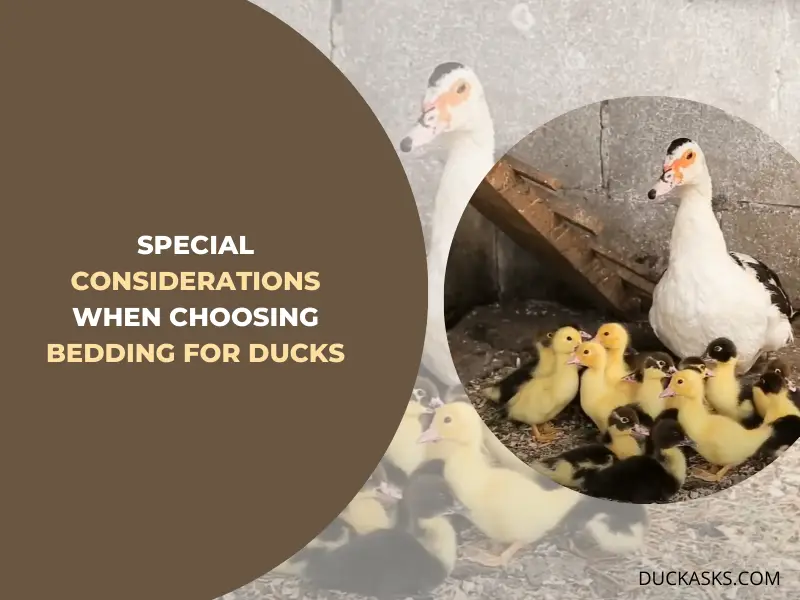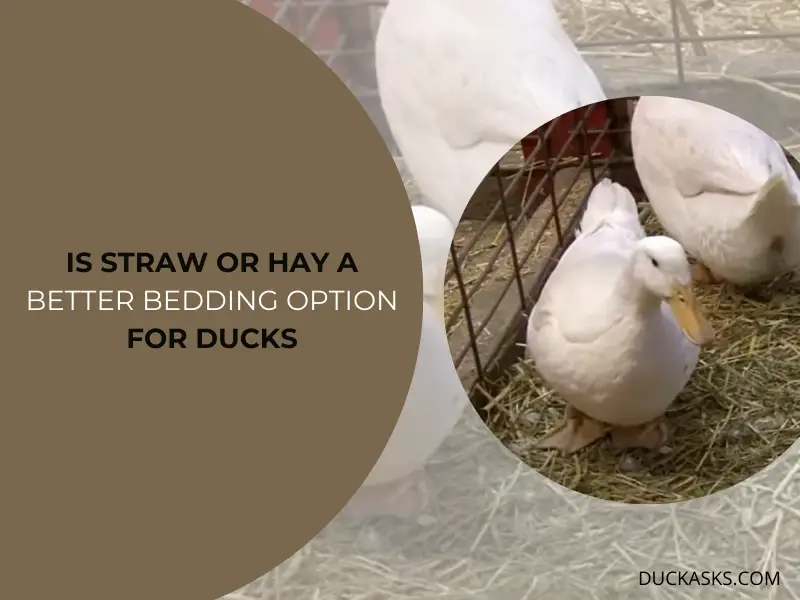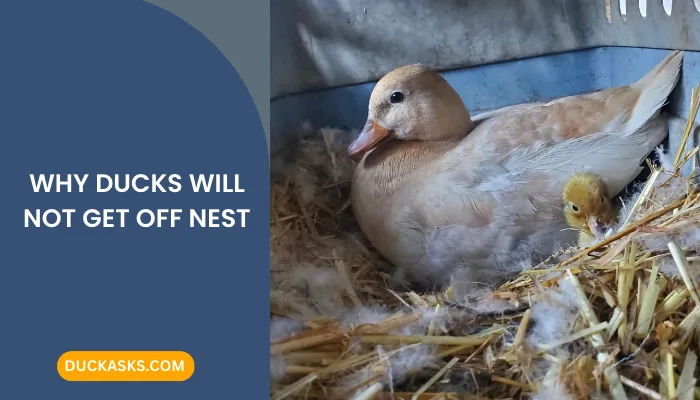What is The Best Bedding for Ducks?
Anyone planning to keep ducks should have a proper idea about setting their housing elements, especially their bedding. Adding your duck bedding can be a huge part of your everyday chores to keep your ducks comfortable and healthy.
Now, you might ask, what is the best bedding for ducks? Generally, ducks are messier than other poultries as they like to splash water and make muddy messes all around. So, you have to make their bedding with absorbent elements like straw, hay, or softwood chips and change them often after getting wet.
In this article, we have discussed all the elements that you need to make perfect bedding for your ducks. Besides, some special considerations in choosing their bedding are also mentioned here.
Want to know more about ducks habitat:
Are There Any Specific Materials that Should be Avoided When Choosing Bedding for Ducks?
When you are choosing bedding for your ducks, you have to make sure that it doesn’t cause any harm to them. Below we have discussed some of the specific materials that you should avoid –
Cedar Wood
Often poultry owners use wood shavings for making duck bedding as it keeps the bedding soft and comfortable. But using cedar wood for this purpose can be harmful for your ducks.
Cedar wood chips often produce dust that can be responsible for the respiratory diseases of your ducks. So, it is better to avoid using this material.
Paper
Using shredded newspapers for duck bedding might seem a good idea because papers can absorb water well.
But papers get wet very easily when they come in contact with the smallest amount of water. As ducks always wet themselves in water and have liquid droppings, paper is not really suitable for making their bedding.
Straw
Though a lot of duck owners prefer using straw beddings for their ducks; sometimes, this material can cause harm to them. When your ducks lay on straw bedding while being wet, it gets damp easily and takes too long to dry.
As a result, ducks can develop aspergillosis; a respiratory disease that can cause several health complications including breathing problems.
If your ducks have a coop or resting place outdoors, you must avoid using straw there.
Maize Cobs
Generally, maize cobs are inappropriate for making duck bedding as they are really hard and can’t absorb much water.
Even if you crush them thoroughly, your ducks can hurt their legs and breasts while walking and sitting on them. So, you should avoid them on your farm.
Are There Any Special Considerations When Choosing Bedding for Ducks?
If you are set on choosing proper bedding for your ducks, you may wonder about numerous things, for example, what is the most absorbent bedding for ducks or how can you choose the right material that would be comfortable for them.

To make your task easier, below we mentioned key considerations that you need to look at while choosing duck bedding.
Absorbency
The most vital thing you should consider while choosing duck bedding is the absorbency of the material. As ducks are water-loving species splashing water here and there, their bedding should be enough absorbent to keep them dry.
Comfort
Ducks play in the water all day long and after having a really tiresome day, they need a comfortable place where they can rest and sleep nicely. So, it is necessary to choose such bedding that can provide them comfort while they stay in the coop.
Cost
As you have to replace the bedding layers of ducks more frequently than other poultries, you need to choose a bedding that is less expensive. You can find duck bedding in different price ranges and choose them according to your budget.
Is It Necessary to Provide Bedding for Ducks that Live in Outdoor Enclosures?
Like the indoor ducks living in shelters, the outdoor ducks also need bedding for taking rest and sleeping at night.
It is better to choose straw for making outdoor bedding as you can pile the layers of straw to make the bed warmer during the winter season. These layers can hold the shape of the bedding so that it doesn’t fall down during heavy wind and rain.
In outdoor enclosures, you don’t have to clean the bedding frequently like in indoor housing. Just put another layer over the previous one as the underlying layers will turn into compost by getting mixed with the soil.
What Is the Best Bedding for Duck Coops?
Among several options like straw, rice hulls, hays, and different wood shavings, straws, and sawdust shavings make the best duck beddings for indoors and have their own advantages.
But whatever bedding you choose for your ducks, you should clean and replace it regularly so that your ducks can live on fresh bedding every day. It will promote their well-being by keeping them healthy and happy.
Straw
Ducks love laying on soft and comfortable layers of straw where they can rest peacefully after a long day of playing and roaming around. Besides, straws provide better insulation to keep them warm on colder days.
Sawdust Shavings
To provide resistance against moisture, sawdust shavings keep the bedding dry for a longer time. Often people find it beneficial using pinewood shavings, but it doesn’t provide enough insulation like the sawdust for passing the cold nights during winter.
Pine Shavings
Large shavings of pinewood can be a considerable option for duck beddings. These are antimicrobial and there are less chances of growing molds in wet pine shavings. Besides, these shavings are gentle on duck feet and keep them comfortable at night.
Sand
Clean and dry sand can be the best option for absorbing all the water and droppings of your ducks. Generally, fungus and molds don’t grow on sand like other materials. But beddings made of sand is not so comfortable and might be hard on ducks.
Rubber Stall Mats
Though rubber stall mats are comfortable for making duck beddings, they are not suitable for absorbing water and handling dampness. But you can install and clean them easily and they can be affordable options for making beddings in the coop.
Diatomaceous Earth
You can use diatomaceous earth to deal with the insects and fungus on your duck beddings. As DE is a sharp particle, it is not a good idea to spread it over the duck bedding directly. You can use it keeping the ducks outside the coop as it can cause respiratory diseases to them.
Grass Clippings
Using grass clippings for duck beddings seems a good idea as they are comfortable and can be used with straw, hay and dried leaves. But if these clippings remain damp for a few hours, they have higher chances of mold and fungus attack.
What Type of Bedding is Most Comfortable for Ducks?
To provide the highest comfort to your lovely ducks in the coop, straw beddings can be a game changer.

Ducks spend a lot of time staying in their coop and layers of straw can make them relaxed to spend all these hours peacefully. But why straw is considered as the most comfortable bedding?
Providing the Highest Quality
Straw from any type of grain works well for making duck beddings and can ensure your ducks better comfort than other materials. Though it contains no harmful particles; still, you can consider certified home-grown straws to be sure of the quality.
Versatile Uses
You can cut the straws into small pieces as they are easy to spread over and make the bedding softer and squishier. Besides, you can also consider mixing wood shavings with the straw to increase the water absorbency and keep the bedding comfortable for a longer time.
Best Fit for Budget
Straws are readily available almost in every season of a year. So, price of straw doesn’t vary much and goes easy on your budget. As you need to replace the bedding layers frequently, straw beddings can be the most affordable option to keep your ducks comfortable and happy.
Are There Any Natural or Organic Bedding Options that are Safe and Effective for Ducks?
Though straw, hay, sawdust, and pine shavings are natural bedding materials for ducks; you may also go for green leaves for a safer and organic option.
You can spread layers of dry leaves and when the upper layer becomes wet and smelly due to the droppings, you can easily make another layer and use it again.
But always make sure to remove the wet leaves as soon as possible as mold can grow if the wet leaves remain on the bedding for too long.
Besides, growing your own straw or collecting them from any organic farm ensures a safer and more convenient option for your ducks.
How to Choose the Best Bedding for Your Ducks?
Choosing a nice and comfortable duck bedding could be a real challenge for any poultry owner. We have listed some quick tips and tricks that could help you out choosing the best bedding –

- Avoid bedding that get wet too fast and remains damp for a long time.
- It should not decay fast as this can allow mold attacks.
- Make sure the bedding doesn’t create dust in the air.
- Choose an easy cleaning material to save your time and labor!
- Avoid hard materials that can’t ensure enough comfort.
Is Straw or Hay a Better Bedding Option for Ducks?
Both straw and hay can be excellent choices for making duck bedding, but in some cases, straw works much better than hay.

| Factors | Straw Bedding | Hay Bedding |
|---|---|---|
| Insulation Capability | Traps warm air, better insulation during winter | Moderate insulation |
| Comfort | Softer and more comfortable | Less comfortable |
| Duration of Relaxation | Provides longer hours of relaxation | Adequate relaxation |
| Wetness Absorption | Effective in absorbing wetness | Effective in absorbing wetness |
| Mold Prevention | Effective in preventing molds | Effective in preventing molds |
| Dampness Handling | May not work as well in dealing with dampness | Effective in handling dampness |
How Often Should Bedding be Changed for Ducks?
Actually, you need to change and replace your duck bedding according to the length of the bedding and the number of ducks you are keeping in the coop.
Because if you have small bedding for a large number of ducklings, it is required to change the bedding frequently.
Generally, it is advised to change the bedding every 48 to 72 hours. It will prevent the dampness from settling inside it and also reduce the chances of mold attacks.
In case you have older ducks in your coop, you should change the bedding layers more frequently depending on the amount of watery mess on it.
Frequently Asked Questions
01. How to keep ducks warm on chilly winter nights?
Whether you make your duck bedding with straw, hay, or wood shavings, place an extra thick layer of straw over the bedding at night. It will increase the insulation of the bedding to keep your ducks warm on chilly winter nights.
02. What is the best bedding for baby ducks?
The bedding of baby ducks gets messy too fast compared to the adult ones. So, pine shavings are considered as the best ones for baby ducks as these can keep the babies comfortable all day long and you can easily change the bedding frequently.
03. Which bedding material is good for a duck coop?
You can use several materials for making bedding for a duck coop which includes dry leaves, straw, hay, and wood shavings. Among them, straw is considered as the best material as it is less expensive, provides high absorbency and better insulation.
Conclusion
Making the best bedding for your ducks might seem hard as you need to consider a lot of things in mind.
But if you have proper planning and enough knowledge about the bedding materials and requirements of your ducks, it will be easier for you eventually.
Proper bedding can keep them dry and comfortable all day long and ensure their well-being. Hopefully, this article serves you well if you are trying to figure out what is the best bedding for ducks.
References Link:
- https://opensanctuary.org/duck-habitat-maintenance-and-cleaning/
- https://www.flytesofancy.co.uk/blogs/information-centre/a-guide-to-keeping-ducks






